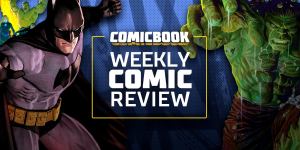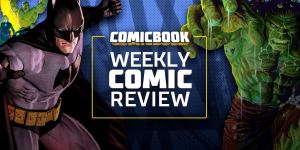This week sees the launch of John Flood, a new series from best-selling writer Justin Jordan and Sleepy Hollow artist Jorge Coelho, from BOOM! Studios.
Videos by ComicBook.com
As the result of a government experiment, lead character John Flood no longer needs to sleep, but now he’s in a constant dream state and sometimes can’t tell what’s real and what isn’t. A side effect is that he sees patterns and makes connections no one else can, which serve him well in his new “career” as a makeshift PI. Together with a burly ex-cop, Flood begins to investigate when he “sees” one man responsible for thousands of unsolved murders, but now he himself has caught the killer’s attention…
Coelho joined ComicBook.com to discuss the series, which debuts today. You can find a copy at your local comic shop or grab one off ComiXology.
You can check out some exclusive process images from the series below, as well.
How did you end up working on this book with Justin?
I’ve been a fan of Justin’s his work since Luther Strode hit the stands. I’ve had creative experiences with mutual friends like Tradd Moore in Brand New Nostalgia, and I also did a pinup illustration for Luther Strode‘s second arc. One can say that both of us, as slaves of our time, belong to the same generation…so (as Mr. Smith would say, inevitably) when the hypothesis arose, I didn’t look back. I’m crazy, not raging mad…
Can you tell us a little bit about the look of this book? What are you doing differently from your last few projects?
In John Flood, we see his hallucinations so that’s a new challenge, seeing through the eyes of a sleep-deprived person. I changed the inking technique a bit for that effect, going more for line work with hatching (more or less distorted depending on the context), alongside standard line work and shadows for reality. Also layouts, layouts, layouts, it’s all in the layouts; I spent a bit of time in there.
Attending Sean Murphy’s Apprenticeship also gave me more tools to develop John Flood with more confidence.
Who are some of your influences? I feel like I see some John Romita, Jr. in there.
I do love Romita Jr.’s work; those early years on X-Men and Daredevil were my personal faves. I’m 38, so Jr.’s generation is big in my universe — Byrne, Miller, Adams, Mignola, Sienkiewicz…
Lately, Sean Murphy’s work had a big impact on me. Plus, living in Portugal—a country turned outwards that is influenced pretty much from everywhere — mixes into something that I can’t be very objective about.
How much do you think doing something with the crazy imagery and over-the-top visual demands of Polarity prepared you for working on this book?
Very much! I don’t feel I did too crazy of a job in Polarity, but yes, having that experience gave me something to build upon. Your past experiences inform your future path very much, and that goes for readers, writers, and editors, too!
How collaborative is the process with Jordan? Do you guys do full script or hammer a lot of stuff out together?
We’re doing full script. Sometimes I add something but I rarely subtract. When I start working it’s like diving: I get so focused on the pages and I don’t communicate much.
The color palette here reminds me a bit of Sleepy Hollow. How important do you think finding the right colorist is for your style?
Very. Not only for my style, but for comics in general. Because comics are a visual medium, colors are very important and having a talented colorist can really make or break (visually) a book. Having Tamra Bonvillain’s talent aboard is already a victory, plus because we worked together before on Sleepy Hollow, we were able to grow and perfect our graphic chemistry in John Flood. I’m just lucky…
You’ve got a world that’s a bit more…I don’ t know…normal?…than your previous BOOM! work in some ways. Is it a challenge to create characters who are visually distinctive and instantly recognizable issue to issue, when they’re all just kind of people you might see out in the world?
The challenge remains the same: to create recognizable and visually interesting characters. Fortunately, the expectations have evolved — I believe that today’s readers have a wider range and don’t frown upon “looking normal” as much as they allegedly did before.
It’s story, really — if it’s well written you’ll relate any which way. This goes for both the readers and the artist. You’ll have interesting characters, impactful scenes to illustrate, and be entertained.
Anything else you want to make sure you tell our readers?
Give John Flood a flick. If you guys catch half the fun we’re having, you’ll dig it.






